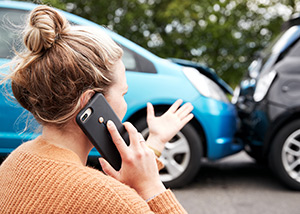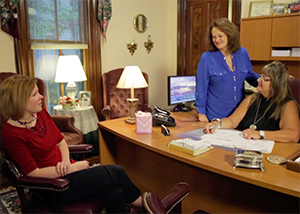
-
- The accident results in fatal, or nonfatal personal injuries to any person
- The accident results in damage to a vehicle rendering it inoperable
The law goes on to state, if the accident results in property damage exceeding $500.00, in which an investigation was not conducted by law enforcement, you shall file a written report of the accident with the Department of Kentucky State Police within ten days of occurrence of the accident. The website link to file a Civilian Collision Report with Kentucky State Police.
The law is clear, if there are injuries of any kind you must immediately notify the police so they can initiate a report. If one of the vehicles is rendered inoperable, regardless of injuries, you also have to immediately notify the police.
If you have any doubt, it is best to go ahead and immediately contact the appropriate police as soon as a collision occurs. The appropriate law enforcement agency may depend on your location, but will typically be city police, sheriff’s department, or state police.
As most people who have been involved in an automobile collision know, it is fairly easy to rack up over $500.00 for any amount of damage to a vehicle. Furthermore, often times you may not realize you are injured, or the extent of your injuries until hours or days following the collision.
You May Not Realize the Extent of Your Injuries Until After the Collision
Minor impacts do not always equal minor injuries. Even car accidents with little to no property damage can cause significant injury. That is why the attorneys at Flora Templeton Stuart Accident Injury Lawyers always recommend that you call the appropriate police department immediately after any collision, even if you are unsure of property damage or injury immediately following the collision.
Even Low Impact Collisions Can Result in Significant Injury
‘Low impact’ accidents are usually defined as those that occur at less than 10 mph. Despite the slower speed, these accidents often cause injuries to car occupants, regardless of visible damage to the vehicle. The fallacy that you cannot suffer injury when there is no visible damage is one that insurance companies have been promoting for years, and it is simply untrue.
Low impact collisions are often bumper-to-bumper. The National Highway Traffic Safety Administration, or NHTSA, has clearly stated that a bumper is intended to protect the vehicle from damage, and are not designed to be structural components that would significantly contribute to “occupant protection during front or rear collisions”.
The NHTSA further states that a bumper “is not a safety feature intended to prevent or mitigate injury severity to occupants in the passenger cars”. Bumpers are designed to protect the hood, trunk, grille, fuel, exhaust and cooling system as well as safety related equipment such as parking lights, headlamps and taillights in low speed collisions, not occupants!
Low Impact Collisions and Soft Tissue Injuries
Soft tissue injuries refer to injuries to body tissue that is not made of bone, which includes muscle, skin, and connective tissues like ligaments, cartilage and tendons. Examples of soft-tissue injury include:
- Cervical Strain
- Lumbar Strain
- Thoracic Strain
- Whiplash
- Bruising or hematoma
- Soreness
- Nerve damage
There is no doubt that an individual can be symptomatic from soft-tissue injuries for weeks, months, or even permanently following a collision. Symptoms from “soft tissue” injuries can include:
- Pain
- Headache
- Numbness or tingling
- Stiffness
- Sensitivity
- Dizziness
- Blurry vision
- Weakness
- Ringing in the ears
- Memory problems
Often, the extent of someone’s soft tissue injury isn’t known until they have an MRI or advanced diagnostic imaging.
Someone suffering with neck pain may have an MRI which shows a serious disc herniation with nerve impingement resulting from the collision. Or, someone with shoulder pain and tightness may find that they have a labrum tear, which is an extremely common injury in automobile collisions, especially for drivers who have theirs hands braced on the steering wheel.
Why is a Police Report Important for My Personal Injury Case?
Police reports establish a written record of your collision and contain very important information about the facts of the collision, the parties involved, and their insurance carriers. Without this information, it may be difficult, or impossible to obtain information about the other party or their insurance carrier. After all, without any information there is no claim to pursue.
Important information that is recorded on the police report can include:
- Pre-Collision Vehicle Action
- Contributing Factors – Human, Vehicular, and Environmental
- Manner of Collision (i.e. sideswipe, rear-end, head on, etc.)
- Person Type (i.e. Driver, Passenger, Pedestrian, Bicyclist, Owner, etc.)
- Was Person Transported to Medical Facility?
- Position
- Injury Severity
- Seatbelt Use
Sometimes the investigating police agency will also diagram or photograph the scene of the collision and/or the vehicles, which may be helpful in proving your case.
Typically, your accident report will be available within a few days, but Kentucky law requires the investigating officer to complete it within ten days following the investigation. Typically, you will be able to obtain a copy of your crash report online via websites like www.buycrash.com, mail, or by stopping by the local law enforcement’s physical office. Many investigating officers will provide you with their card containing contact information and a report number, or a BuyCrash card with a number to order the report online.
Car Accident FAQ’s
How Will My Attorney Get Paid?

Who Will Pay for the Damage to my Vehicle?
Often times, clients wish to pursue property damage through the at-fault parties insurance carrier. You can also pursue property damage with your own carrier, but you may be subject to a deductible depending on your policy. Sometimes, your insurance may be willing to waive the deductible and go after the at-fault parties carrier directly, or reimburse you later on if they make a recovery of the property damage cost.
If you are in need of a rental car, but do not have rental coverage on your own policy, it may be best to go through the other carrier. However, this may take several days or even weeks, as the insurance company will want a copy of the police report and likely will want to speak to their insured and any witnesses. The experienced attorneys and Flora Templeton Stuart Accident Injury Lawyers can help guide you through this process, with no fee for property damage assistance.
When Should I Contact An Attorney?
As discussed, you should contact law enforcement and if injured get medical treatment immediately upon having a wreck. Then, you should contact an injury lawyer close to you as soon as you can after a car accident. We are available 24/7 even on weekends and we travel to our injured clients who cannot come to us.
Call the Experienced Attorneys at Flora Templeton Stuart Accident Injury Lawyers Today!
If you have been injured in a car accident, contact Flora Templeton Stuart today for your free consultation by submitting a case evaluation form, chat with us on our website, or by calling 888-782-9090. Remember, at our law firm you will get the top attorney to represent you with local offices close to you. Personal representation is our motto.
With offices throughout Kentucky and Tennessee, Flora Templeton Stuart and her team will travel to you if you can’t come to us and answer any questions you may have about your case.
